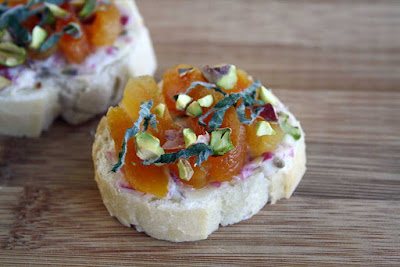 |
| Photo credit: “World Map – Abstract Acrylic.” Photo by Nicolas Raymond. Painting by Lara Mukahirn. Some rights reserved. Retrieved here. |
About a year ago, I challenged myself to spend 2017 exploring more cultures through food. It's been a fun and scrumptious year! I've enjoyed the challenge of seeking out new recipes, techniques, ingredients, and flavor combinations from all over the world. Also, aiming for one country each month was just about perfect--it was doable and consistent.
And because bloggers are supposed to do end-of-year round-ups, here's a rundown of the foods I've gotten to experience this year, as well as some new ingredients and equipment that have found new homes in my kitchen.
Looking ahead to 2018, I plan to keep experimenting with different international cuisines! Near the top of my list: Bangladesh and Poland.
January: Peru
Menu and write-up are herePeruvian Beef Kebabs (Anticuchos with Roasted Yellow Pepper Sauce)
Potatoes with Huancaina Sauce (Papa a la Huancaina)
Sarsa Salad
Crema Volteada
February: Tunisia
Menu and write-up are hereChicken Kebabs with Currant and Olive Relish
Slata Mechouia (Grilled Salad)
Orange Almond Cake
March: Hungary (and kinda Romania)
Hungarian Tomato-Pepper Stew (Lesco) - and we served it over polenta, because apparently polenta is a common breakfast element in Romania.April: Vietnam
Vietnamese Shrimp Noodle Bowl (Bun Tom Xao) - fresh, crunchy, and bursting with flavor.May: Finland and Dutch West Indies
Finnish Pulla Bread with Apricots and Pistachios - one of the most beautiful things I've ever made. I was so proud of these glisteningly bronzed braids!Dutch West Indian Chicken Kebabs (Boka Dushi) with Dutch West Indian Peanut Sauce - with most dishes, I have a pretty good idea of how they're going to taste. This one, however, combined so many ingredients that I wouldn't have thought to combine, that I truly didn't know what to expect from the finished dish. Happily, it turned out to be one of my favorite dishes this year. We served it with a side of sauteed plantains.
June
My job is crazy-busy every June, so I didn't officially try any new countries. But the Tunisian menu got an encore performance, and I vaguely remember trying a new Thai dish.July: Madagascar and Ethiopia
Malagasy Chicken with Ginger (Akoho Sy Sakamalao) - another favorite this year, largely because it surprised me with how good the finished dish was despite the fairly simple ingredients and preparation technique.Ethiopian Cucumber-Mango Salad
August
For the life of me, I can't remember what country (if any) I cooked in August. But I did try preserved lemons for the first time, and those are used a lot in north African and Mediterranean dishes.September: Myanmar
Burmese Ginger Salad (Gin Thoke) - this salad had so much going on. It was strong on the ginger and lemon, crunchy from the cabbage, and filling thanks to the chickpeas and lentils.Also some Pineappleade which is kinda generically Southeast Asian.
Also an encore of the Malagasy chicken.
October: Somalia
Somali Beef Stew with Spiced Rice (Bariis Maraq) - making this meal included mixing up a classic Somali spice blend, called xawaash, which was a key player in both the stew and the spiced rice. If you make this, do yourself a favor and don't skip the bananas. They seemed to me like an odd topping, but my favorite bites were ones that included banana. As a fun side note, this dish was part of a global food spread that my house church did in celebration of World Food Day.November: Germany
Obatzter (Camembert cheese spread)Bavarian Soft Pretzels
December: Spain
Rustic Spanish Bread (Pan Rustico) - simple and good. In light of the holidays, birthday, and being knocked out with a cold for a few days, something simple was all I could manage this month.New Ingredients and Equipment
- Aji amarillo - yellow pepper paste from Peru
- Almond meal - sure, it's widely used here in the States, but Tunisia inspired me to use it for the first time
- Hungarian wax peppers - mild spice level, and they were readily available at Walmart
- Kitchen scale - this inexpensive but reliable scale is suuuuuper helpful with recipes with measurements written in grams and ounces rather than cups and teaspoons ... which happens often when using recipes that didn't originate in the U.S.
- Orange blossom water - basically the elixer of the gods
- Pistachios - though I never cared for them before, I used (and enjoyed!) them quite a bit this year
- Pomegranate molasses - made my own; used in this Pomegranate Molasses Chicken
- Preserved lemons - when my current jar runs out, I want to try making my own
- Spice grinder - this year my eyes (and taste buds) were opened to the wonderful world of grinding one's own spices right before tossing them into a dish. Grinding whole cloves, peppercorns, and cumin seeds will give you much more punch than measuring out pre-ground spices. I use my Magic Bullet which I've had for awhile, and I've heard that a coffee grinder or a mortar and pestle work quite well.
- Sumac - ground spice used a lot in Middle Eastern foods; bought at Cordell's; I'd eaten it before but hadn't cooked with it
- Xawaash - Somalian spice blend featuring cinnamon, coriander, cumin, black pepper, cardamom, cloves, and turmeric; recipe is included in the Somali stew recipe above.















